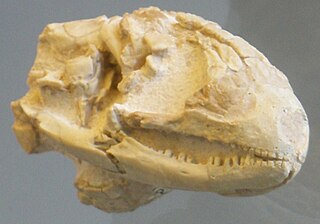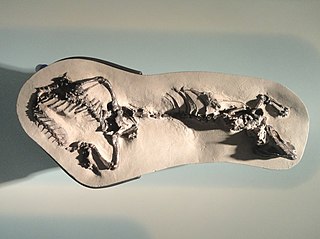
Anguidae refers to a large and diverse family of lizards native to the Northern Hemisphere. Common characteristics of this group include a reduced supratemporal arch, striations on the medial faces of tooth crowns, osteoderms, and a lateral fold in the skin of most taxa. The group includes the slowworms, glass lizards, and alligator lizards, among others. The family is divided into three subfamilies, and contains about 100 species in 10 genera.
The Late Cretaceous is the younger of two epochs into which the Cretaceous geological period is divided in the geologic time scale. Rock strata from this epoch form the Upper Cretaceous series. The Cretaceous is named after the white limestone known as chalk which occurs widely in northern France and is seen in the white cliffs of south-eastern England, and which dates from this time.

Pachycephalosaurus is a genus of pachycephalosaurid dinosaurs. The type species, P. wyomingensis, is the only known species. It lived during the Late Cretaceous Period of what is now North America. Remains have been excavated in Montana, South Dakota, Wyoming and Alberta. It was a herbivorous creature which is primarily known from a single skull and a few extremely thick skull roofs, at 9 inches thick. More complete fossils have been found in recent years. Pachycephalosaurus was one of the last non-avian dinosaurs before the Cretaceous–Paleogene extinction event. Another dinosaur, Tylosteus of western North America, has been synonymized with Pachycephalosaurus, as have the genera Stygimoloch and Dracorex in recent studies.

Enchodus is an extinct genus of aulopiform ray-finned fish related to lancetfish and lizardfish. Species of Enchodus flourished during the Late Cretaceous, and survived the Cretaceous–Paleogene extinction event, persisting into the late Eocene.

Richardoestesia is a morphogenus of theropod dinosaur teeth, originally described from the Late Cretaceous of what is now North America. It currently contains two species, R. gilmorei and R. isosceles. It has been used as a morphotaxon to describe other theropod teeth widely displaced in time and space from the type species.
The Maastrichtian is, in the ICS geologic timescale, the latest age of the Late Cretaceous epoch or Upper Cretaceous series, the Cretaceous period or system, and of the Mesozoic era or erathem. It spanned the interval from 72.1 to 66 million years ago. The Maastrichtian was preceded by the Campanian and succeeded by the Danian.

Peltosaurus is an extinct genus of anguid lizard from North America that lived from the Eocene to the Oligocene. Peltosaurus belongs to the anguid subfamily Glyptosaurinae. The type species Peltosaurus granulosus was named in 1873 by American paleontologist Edward Drinker Cope. Many additional species have been named, but most have been reassigned to different genera. For example, Peltosaurus piger, named in 1928, was reclassified as Odaxosaurus piger, and P. jepseni, named in 1942 from the Paleocene of Wyoming, but was later reclassified as Proxestops jepseni. In 1955 a new species, Peltosaurus macrodon, was named from the Eocene of California. Lizard bones from the Late Miocene of Nebraska were attributed to a new species of Peltosaurus called P. minimus in 1976, extending the fossil range of Peltosaurus and Glyptosaurinae into the Neogene. However, these bones were later referred to a genus of skinks called Eumeces, meaning that the fossil range of Peltosaurus and Glyptosaurinae does not go beyond the Paleogene.

Ichthyornithes is an extinct group of toothed avialans very closely related to the common ancestor of all modern birds. They are known from fossil remains found throughout the late Cretaceous period of North America, though only one species, Ichthyornis dispar, is represented by complete enough fossils to have been named. Ichthyornitheans became extinct at the Cretaceous–Paleogene boundary, along with enantiornitheans, all other non-avian dinosaurs, and many other animal and plant groups.

Caenagnathidae is a family of bird-like maniraptoran theropod dinosaurs from the Cretaceous of North America and Asia. They are a member of the Oviraptorosauria, and close relatives of the Oviraptoridae. Like other oviraptorosaurs, caenagnathids had specialized beaks, long necks, and short tails, and would have been covered in feathers. The relationships of caenagnathids were long a puzzle. The family was originally named by Raymond Martin Sternberg in 1940 as a family of flightless birds. The discovery of skeletons of the related oviraptorids revealed that they were in fact non-avian theropods, and the discovery of more complete caenagnathid remains revealed that Chirostenotes pergracilis, originally named on the basis of a pair of hands, and Citipes elegans, originally thought to be an ornithomimid, named from a foot, were caenagnathids as well.
The Paleocene, or Palaeocene, is a geological epoch that lasted from about 66 to 56 million years ago (mya). It is the first epoch of the Paleogene Period in the modern Cenozoic Era. The name is a combination of the Ancient Greek palæo- meaning "old" and the Eocene Epoch, translating to "the old part of the Eocene".

The Aguja Formation is a geological formation in North America, exposed in Texas, United States and Chihuahua and Coahuila in Mexico, whose strata date back to the Late Cretaceous. Dinosaur remains are among the fossils that have been recovered from the formation.
Socognathus is a genus of prehistoric chamopsiid polyglyphanodontian lizards containing species that lived from the Middle Campanian stage to the late Maastrichtian. Several specimens of the type species, Socognathus unicuspis, have been found in Alberta, Canada. A second species, Socognathus brachyodon is known from the late Maastrichtian Lance Formation; its fossils have been found in Wyoming, United States.
Obamadon is an extinct genus of polyglyphanodontian lizards from the Late Cretaceous of North America. Fossils have been found in the Hell Creek Formation of Montana and the Lance Formation of Wyoming. Researchers describe it as being distinguished by its "tall, slender teeth with large central cusps separated from small accessory cusps by lingual grooves." The type species was named Obamadon gracilis after United States president Barack Obama, "in reference to the tall, straight teeth, and the manner in which Mr. Obama has acted as a role model of good oral hygiene for the world." According to Nicholas R. Longrich of Yale University, the creature "was probably a foot long, [and] with these tall, slender teeth it used to eat insects and plant matter."

Polyglyphanodontia, also known as the Borioteiioidea, is an extinct clade of lizards from the Cretaceous that includes around a dozen genera. Polyglyphanodontians were the dominant group of lizards in North America and Asia during the Late Cretaceous. Most polyglyphanodontians are Late Cretaceous in age, though the oldest one, Kuwajimalla kagaensis, is known from the Early Cretaceous Kuwajima Formation (Japan). Early Cretaceous South American taxon Tijubina, and possibly also Olindalacerta, might also fall within Polyglyphanodontia or be closely allied to the group, but if so, they would be two of only three Gondwanan examples of an otherwise Laurasian clade. They produced a remarkable range of forms. Chamopsiids, including Chamops, were characterized by large, blunt, crushing teeth, and were most likely omnivores. Macrocephalosaurus, from the Gobi Desert, was a specialized herbivore; it grew to roughly a meter long and had multicusped, leaf-shaped teeth like those of modern iguanas. Polyglyphanodon, from the Maastrichtian of Utah, was another herbivore, but its teeth formed a series of transverse blades, similar to those of Trilophosaurus. Peneteius had remarkable, multicusped teeth, similar to those of mammals. The polyglyphanodontids first appear in the latter part of the Early Cretaceous in North America, and became extinct during the Cretaceous-Paleogene extinction event. Polyglyphanodontians closely resembled the teiid lizards, and purported teiid lizards from the Late Cretaceous appear to be polyglyphanodontians. The only species known to have survived the Cretaceous was Chamops, which survived until the very early Ypresian.

The Cretaceous–Paleogene (K–Pg) extinction event was a sudden mass extinction of three-quarters of the plant and animal species on Earth, approximately 66 million years ago. With the exception of some ectothermic species such as the sea turtles and crocodilians, no tetrapods weighing more than 25 kilograms survived. It marked the end of the Cretaceous period, and with it the end of the entire Mesozoic Era, opening the Cenozoic Era that continues today.
Archaerhineura was a genus of amphisbaenian lizards in the family Rhineuridae that is now extinct. The only species is Archaerhineura mephitis, named in 2015 on the basis of a single fragment of the lower jaw from the Polecat Bench Formation in Park County, Wyoming, which dates to the late Paleocene. Archaerhineura is one of the oldest amphisbaenians and was part of an evolutionary radiation of Rhineuridae in the Paleocene several million years after the Cretaceous–Paleogene extinction event. This rhineurid radiation coincided with the radiation of another group of amphisbaenians, Amphisbaeniformes, which includes the still-extant families Blanidae and Amphisbaenidae. The presence of Archaerhineura and other Paleocene rhineurids in the western United States indicates that amphisbaenians, which would later have a nearly global distribution, originated in North America.
Dryadissector is an extinct genus of varanoid lizard represented by the type species Dryadissector shilleri from the Late Cretaceous of Texas. Dryadissector is known only from isolated teeth, which may have been shed by living individuals. These teeth are common in early Campanian strata within the Aguja Formation, which date back about 80 to 82 million years. The teeth of Dryadissector are extremely similar to those of theropod dinosaurs, which led to them initially being misidentified as the remains of theropods. Like theropod teeth, the teeth of Dryadissector are recurved, laterally compressed, and serrated. However, their lizard affinities are made evident by serrations that are smaller and more numerous than those of theropods, as well as a bulge on the inner surface of the base of each tooth that is characteristic of varanoids.
Catactegenys is an extinct genus of xantusiid lizard from the Late Cretaceous of Texas. The type species, Catactegenys solaster, was named in 2013 from the late-Campanian-age Aguja Formation in Brewster County. The genus name means "breaker jaw" in Greek, a reference to its inferred ability to break hard shells with its jaws as an adaptation for a durophagous diet, and the species name means "lone star", a reference to Texas, the "lone star state". Catactegenys is known only from jaw bones, but the size of these bones indicates that it was larger than all other known xantusiids. The teeth are robust and heavily worn, suggesting that Catactegenys may have eaten hard-shelled molluscs, which are common in the Aguja Formation.
Pariguana is an extinct genus of iguanid lizard from the Late Cretaceous of western North America. It is known from a single type species, Pariguana lancensis, named in 2012 on the basis of a partial lower jaw from the Lance Formation in eastern Wyoming. This jaw bone comes from a layer dated approximately 650,000 years before the Cretaceous–Paleogene extinction event. Pariguana is the oldest definitive iguanid from North America, and may represent the first stage of the iguanian evolutionary radiation from Asia into North America.

Coniophis is an extinct genus of snakes from the late Cretaceous period. The type species, Coniophis precedes, was about 7 cm long and had snake-like teeth and body form, with a skull and a largely lizard-like bone structure. It probably ate small vertebrates. The fossil remains of Coniophis were first discovered at the end of the 19th century in the Lance Formation of the US state of Wyoming, and were described in 1892 by Othniel Charles Marsh. For the genus Coniophis, a number of other species have been described. Their affiliation is, however, poorly secured, mostly based on vertebrae descriptions from only a few fossils.










